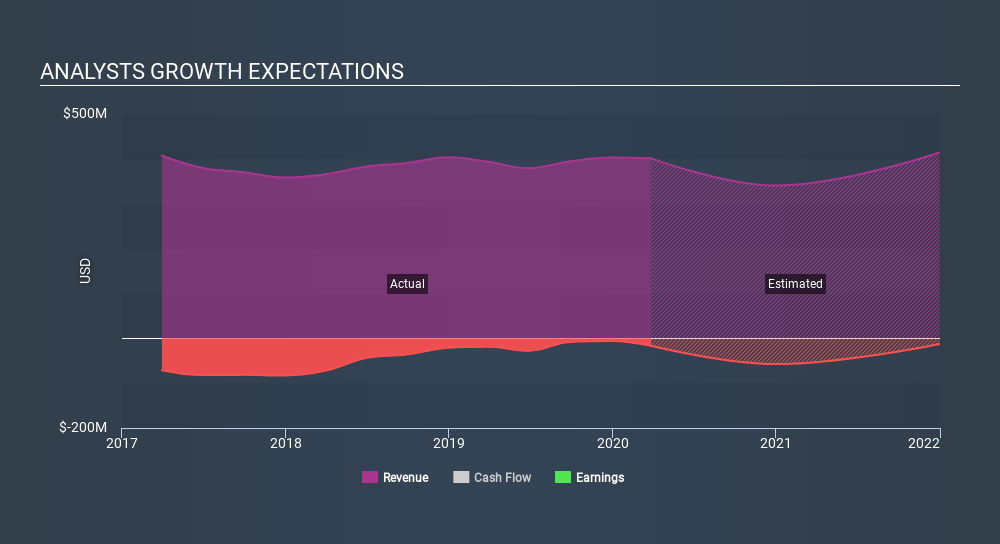- United States
- /
- Communications
- /
- NasdaqGS:HLIT
Time To Worry? Analysts Are Downgrading Their Harmonic Inc. (NASDAQ:HLIT) Outlook

The latest analyst coverage could presage a bad day for Harmonic Inc. (NASDAQ:HLIT), with the analysts making across-the-board cuts to their statutory estimates that might leave shareholders a little shell-shocked. Revenue and earnings per share (EPS) forecasts were both revised downwards, with analysts seeing grey clouds on the horizon.
Following the latest downgrade, the current consensus, from the seven analysts covering Harmonic, is for revenues of US$341m in 2020, which would reflect a not inconsiderable 15% reduction in Harmonic's sales over the past 12 months. Losses are supposed to balloon 226% to US$0.59 per share. Yet prior to the latest estimates, the analysts had been forecasting revenues of US$407m and losses of US$0.22 per share in 2020. Ergo, there's been a clear change in sentiment, with the analysts administering a notable cut to this year's revenue estimates, while at the same time increasing their loss per share forecasts.
View our latest analysis for Harmonic

The consensus price target fell 40% to US$7.86, implicitly signalling that lower earnings per share are a leading indicator for Harmonic's valuation. There's another way to think about price targets though, and that's to look at the range of price targets put forward by analysts, because a wide range of estimates could suggest a diverse view on possible outcomes for the business. There are some variant perceptions on Harmonic, with the most bullish analyst valuing it at US$9.00 and the most bearish at US$5.75 per share. This shows there is still some diversity in estimates, but analysts don't appear to be totally split on the stock as though it might be a success or failure situation.
Another way we can view these estimates is in the context of the bigger picture, such as how the forecasts stack up against past performance, and whether forecasts are more or less bullish relative to other companies in the industry. One more thing stood out to us about these estimates, and it's the idea that Harmonic'sdecline is expected to accelerate, with revenues forecast to fall 15% next year, topping off a historical decline of 0.2% a year over the past five years. By contrast, our data suggests that other companies (with analyst coverage) in a similar industry are forecast to see their revenue grow 3.8% per year. So while a broad number of companies are forecast to decline, unfortunately Harmonic is expected to see its sales affected worse than other companies in the industry.
The Bottom Line
The most important thing to take away is that analysts increased their loss per share estimates for this year. Unfortunately analysts also downgraded their revenue estimates, and industry data suggests that Harmonic's revenues are expected to grow slower than the wider market. With a serious cut to this year's expectations and a falling price target, we wouldn't be surprised if investors were becoming wary of Harmonic.
Even so, the longer term trajectory of the business is much more important for the value creation of shareholders. We have estimates - from multiple Harmonic analysts - going out to 2021, and you can see them free on our platform here.
Of course, seeing company management invest large sums of money in a stock can be just as useful as knowing whether analysts are downgrading their estimates. So you may also wish to search this free list of stocks that insiders are buying.
If you spot an error that warrants correction, please contact the editor at editorial-team@simplywallst.com. This article by Simply Wall St is general in nature. It does not constitute a recommendation to buy or sell any stock, and does not take account of your objectives, or your financial situation. Simply Wall St has no position in the stocks mentioned.
We aim to bring you long-term focused research analysis driven by fundamental data. Note that our analysis may not factor in the latest price-sensitive company announcements or qualitative material. Thank you for reading.
About NasdaqGS:HLIT
Flawless balance sheet and undervalued.
Similar Companies
Market Insights
Community Narratives





